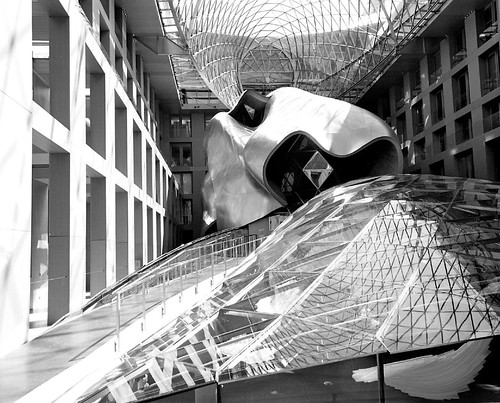
December 14, 2009
In a F.O.G.
 Image of DZ Bank, Berlin, by Manuela Martin
Image of DZ Bank, Berlin, by Manuela Martin
The fall semester is not yet over, and I have been plunged into spring semester planning. I am teaching architecture criticism again, this time to undergraduates in NYU’s Urban Design and Architecture Studies program. I am thinking of adding films for the first time, partly as a fill-in for days when written critiques are due and few students actually do the reading assignment (2.5 hours is a long time when no one has anything to say but me), partly as a way to show a different form of architectural criticism, partly to give them something else to critique. The problem may be in keeping my mouth shut.
I started my pre-viewing with Sketches of Frank Gehry, Sydney Pollack’s 2005 documentary. I have been avoiding this film for years, not a Gehry fan, and I thought I might not make it through the first five minutes, so saccharine was the tone. I calmed down, and so did the hagiography (for a while), but I can’t say I learned a thing. It is deeply strange when a film about a contemporary architect never mentions any other living practitioner of architecture; uses only friends of Frank, all artists, buddies, clients (or all three), to comment on his work; and treats the only living architect most people have heard of as an embattled revolutionary figure. Maybe that was true of Gehry in 1975, or even 1985, but it is not any more, and after years of group therapy, he should know it. (As a side note, when Gehry’s therapist mentions that other architects have come to him hoping to be head-shrunk into geniuses, I couldn’t help but think of my husband’s former boss, also a group therapy habitue, and also someone who thinks of himself as an embattled revolutionary figure.)
Sketches plays like what it is, a noodling side project for a couple of old friends (Pollock is on camera half the time, and we often hear him agreeing with whatever Barry Diller, Thomas Krens et al. are saying in praise), tanned, leather-jacketed, successful. Gehry’s aw-shucks act is only eclipsed by Pollock’s, in a scene where he acts as if he has no idea why Frank asked him to make the documentary, and hasn’t the least idea how to do it.
But maybe he doesn’t. If the adulation hadn’t gotten to me, the lack of any brilliant scenography would have. The good thing about a film about architecture occasionally making it into theaters is the opportunity to expose more people to the thrills of buildings far away. The experiential and emotional qualities that the late Herbert Muschamp (also on screen praising Gehry above all others) was so good at dramatizing can be shown. But Pollock only tells, largely shooting the outsides of Gehry’s buildings in no particular order. The inside shots are static overviews with busy people. We never follow a ramp, discover titanium around a corner, get blinded by a reflection. We never get down on the ground, so one of the most interesting and controversial aspects of Gehry’s work, its urbanism, is totally lost.
I could go on: about the punch-pulling inherent in using an academic critic like Hal Foster, with whom no viewer will ever identify, as the lone negative voice; about the vague and invidious rejection of unnamed other architects’ work as “white cubes”; and so forth. But I won’t, because the way Gehry and Pollock set it up, I can only sound like a stick-in-the-mud unable to accept change.
Observed
View all
Observed
By Alexandra Lange
Related Posts

The Observatory
Delaney Rebernik|Analysis
A story of bad experiential design

The Observatory
Ellen McGirt|Essays
Lessons in wandering

Architecture
Sameedha Mahajan|Design and Climate Change
The airport as borderland: gateways for some, barriers for others

The Observatory
Alexis Haut|Analysis
“Pay us what you owe us”
Related Posts

The Observatory
Delaney Rebernik|Analysis
A story of bad experiential design

The Observatory
Ellen McGirt|Essays
Lessons in wandering

Architecture
Sameedha Mahajan|Design and Climate Change
The airport as borderland: gateways for some, barriers for others

The Observatory
Alexis Haut|Analysis

 Alexandra Lange is an architecture critic and author, and the 2025 Pulitzer Prize winner for Criticism, awarded for her work as a contributing writer for Bloomberg CityLab. She is currently the architecture critic for Curbed and has written extensively for Design Observer, Architect, New York Magazine, and The New York Times. Lange holds a PhD in 20th-century architecture history from New York University. Her writing often explores the intersection of architecture, urban planning, and design, with a focus on how the built environment shapes everyday life. She is also a recipient of the Steven Heller Prize for Cultural Commentary from AIGA, an honor she shares with Design Observer’s Editor-in-Chief,
Alexandra Lange is an architecture critic and author, and the 2025 Pulitzer Prize winner for Criticism, awarded for her work as a contributing writer for Bloomberg CityLab. She is currently the architecture critic for Curbed and has written extensively for Design Observer, Architect, New York Magazine, and The New York Times. Lange holds a PhD in 20th-century architecture history from New York University. Her writing often explores the intersection of architecture, urban planning, and design, with a focus on how the built environment shapes everyday life. She is also a recipient of the Steven Heller Prize for Cultural Commentary from AIGA, an honor she shares with Design Observer’s Editor-in-Chief,